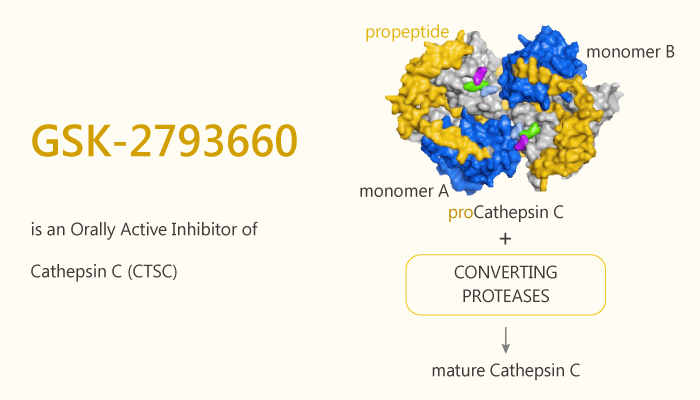Cathepsin C (CTSC) acts as the key activator of the proenzymes of several neutrophil granule‐associated serine proteases (NSPs). CTSC also plays a role in the activation of other leucocyte‐derived serine proteases. These proteases include granzymes A and B, mast cell chymase, and neutrophil serine protease 4. GSK-2793660 is an oral and irreversible, substrate competitive, potent, and selective CTSC inhibitor, with an IC50 value between 0.43 and 1 nM against CTSC.
The role of Cathepsin C in the activation of the neutrophil proteases has been verified. The complete or near-complete loss of function mutations of the CTSC gene in humans associated with Papillon–Lefèvre syndrome (PLS) and Haim–Munk syndrome, rare autosomal recessive diseases characterized by hyperkeratosis of the palms and soles of the feet and severe periodontitis. In addition, the effectively irreversible nature of GSK-2793660 inhibition of Cathepsin C enables a high degree of enzyme inhibition. However, GSK-2793660 inhibits CTSC activity but not the activity of downstream neutrophil serine proteases.
GSK-2793660, as a Cathepsin C inhibitor for the treatment of cystic fibrosis, non-cystic fibrosis bronchiectasis, ANCA-associated vasculitis and bronchiectasis. CTSC is necessary for the activation of several serine proteases including neutrophil elastase (NE), cathepsin G, and proteinase 3. Moreover, single, oral doses of GSK-2793660 are able to dose‐dependently inhibit whole blood CTSC activity. GSK-2793660 inhibits CTSC activity but not the activity of downstream neutrophil serine proteases. In particular, it, an oral, irreversible inhibitor, inhibits whole blood CTSC activity in a dose‐dependent manner. Furthermore, it exhibits a very short systemic half‐life (~1.5 h).

In summary, GSK-2793660 is an oral, irreversible inhibitor of Cathepsin C. GSK-2793660 can be used in the research of cystic fibrosis, non-cystic fibrosis bronchiectasis, ANCAassociated vasculitis and bronchiectasis.